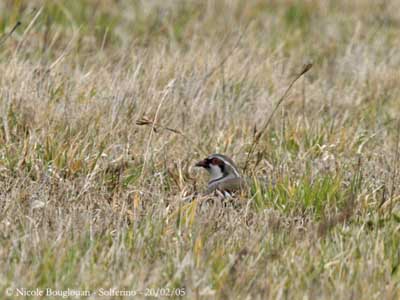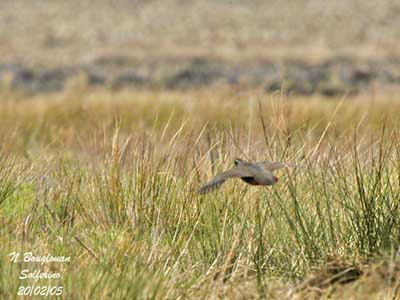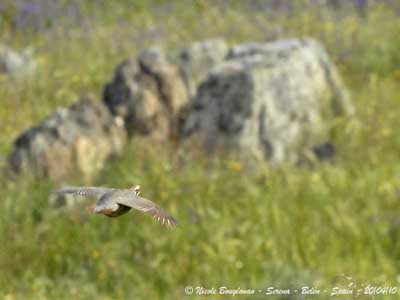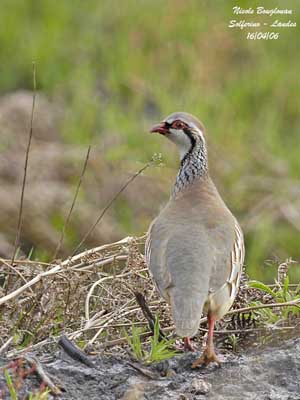
Red-legged Partridge
Alectoris rufa
Galliforme Order – Phasianidae Family
BIOMETRICS :
Length: 34-38 cm
Wingspan: 47-50 cm
Weight: M : 480-547 g – F : 391-514 g
DESCRIPTION:
Red-legged Partridge male has sandy-grey upperparts, including upperwing. Tail has sandy-grey uppertail coverts, but rectrices are buffy-chestnut.
Fr: Perdrix rouge
All : Rothuhn
Esp: Perdiz Roja
Ital: Pernice rossa
Nd: Rode Patrijs
Russe: Рыжая горная куропатка
Sd: Rödhöna
Photographs and text by Nicole Bouglouan
Sources:
HANDBOOK OF THE BIRDS OF THE WORLD Vol 2 by Josep del Hoyo-Andrew Elliot-Jordi Sargatal - Lynx Edicions - ISBN: 8487334156
THE HANDBOOK OF BIRD IDENTIFICATION FOR EUROPE AND THE WESTERN PALEARCTIC by Mark Beaman, Steve Madge - C.Helm - ISBN: 0713639601
THE COMPLETE BOOK OF BRITISH BIRDS – Written by “Royal Society for the Protection of Birds” experts - Préface de Magnus Magnusson - Michael Cady- Rob Hume Editors - ISBN: 0749509112
Hennache, A. & Ottaviani, M. (2011). Cailles, Perdrix et Francolins de l'Ancien Monde, 400 pages. Editions W.P.A. France, Clères, France. ISBN 978-2-9512467-3-7
Hennache, A. & Ottaviani, M. (2005). Monographie des faisans, volume 1. Edition W.P.A. France, Clères, France. ISBN: 2-9512467-1-4
Hennache, A. & Ottaviani, M. (2006). Monographie des faisans, volume 2. Edition W.P.A. France, Clères, France.ISBN: 2-9512467-2-2
"Les auteurs renoncent à leurs droits d'auteurs pour que la vente de cet ouvrage, publié par la World Pheasant Association, soit destinée à soutenir des projets de conservation."
BirdLife International (BirdLife International)
Wikipedia (Wikipedia, The Free Encyclopedia)

On the underparts, chin and throat are white. A black stripe runs from eye to eye, extends from below the eye and borders chin and throat, forming a black collar. The black colour continues down to the neck, forming black triangular patches on the pale sandy-grey breast.
These small black patches end in fine streaks behind the black stripe on the neck sides. The lower neck sides are buffy-brown.
Belly and undertail coverts are rufous. Flanks are heavily marked by bright rufous-brown vertical bars. Each bar shows fine black and white edges on the pale blue-grey background.
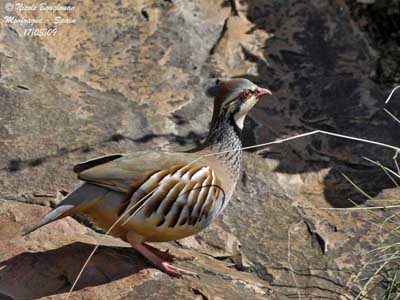
On the head, crown and nape are rufous-brown, and the crown shows a short crest when the bird is alarmed or excited. Forehead is pale blue-grey. A white supercilium extends from lores to the sides of the rear crown and the nape. Lores are black, and the colour joins the black stripe behind the eye.
The bill is red. Eyes are brown, surrounded by red eye-ring. Legs and feet are red, with small tarsal spur.
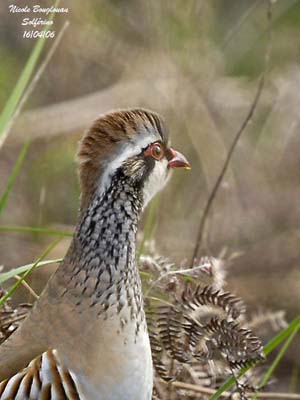
Female has similar plumage, but head and throat are duller and she lacks the spur.
Immature is duller and smaller, with less conspicuous pattern.
We find three subspecies:
A.r. rufa, from France, Italy, Elba and Corsica.
A.r. hispanica, from Iberian Peninsula.
A.r. intercedens, from Iberian Peninsula and Balearic Islands.
This species has been introduced in England and Atlantic Islands.
These races are very similar, with some differences in intensity of colours.
VOICE: SOUNDS BY XENO-CANTO
Red-legged Partridge male utters loud, harsh, repeated “goCHAK-CHAK-CHAK goCHAK goCHAK-CHAK…” as advertising call.
Both sexes give repeated “goCHOK CHOK CHOKORRR” or “pi-tuk tuk tuk cheer”.
They utter repeated, low “tchree-agh” when flushed.
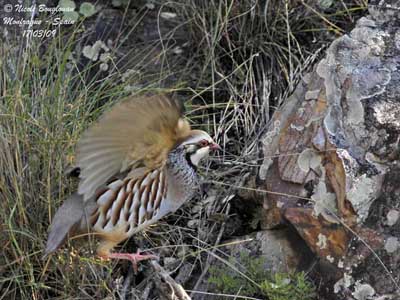
HABITAT:
Red-legged Partridge frequents lowland areas, avoiding forest and wet areas. This species may be seen in dry hilly land with small bushes, and may occur up to 1300 metres of elevation, sometimes, but rarely higher, up to 2000 metres.
It is often seen in orchards, plantations, cultivated areas, grassy hillsides, but also in drier arable lands, heaths and dunes.
RANGE:
Red-legged Partridge is found in Western Europe, in France and Spain, and has been introduced in Great Britain 200 years ago, and also in Atlantic Islands.
BEHAVIOUR:
Red-legged Partridge feeds mainly on varied plant matter, and also ants, grasshoppers and other insects. It feeds mainly on the ground by snapping at insects, gleaning seeds, turning over the leaf-litter or digging into the soil for roots and tubers.
Red-legged Partridge feeds after emerging from the roost in the early morning, and in the late afternoon. Usually, it rests in sheltered perch during the midday.
This species is mostly sedentary, but some birds may perform altitudinal movements in winter, reaching lower grounds.
Red-legged Partridges are often seen in flock of up to 20 birds, wandering over fields and pastures. The dull colours of the upperparts make this bird almost invisible among the low vegetation.
They often crouch low into a depression, and if disturbed, they run away rather than take off.
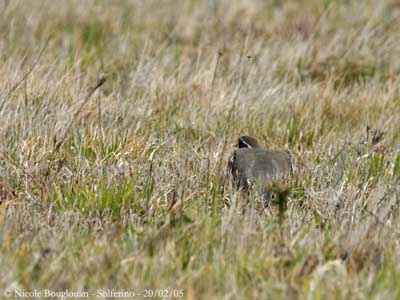
But they also can burst into the air if they are taken by surprise at close range. They fly with whirring wing-beats and glide down to the ground, and then, they run fast.
This bird often perches on high structures, walls or old farm buildings.
FLIGHT:
Red-legged Partridge performs long glides between the bursts of whirring wing-beats.
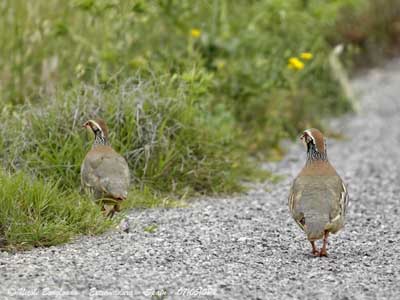
Female lays 10-16 creamy eggs with reddish-brown spots. Incubation lasts about 23-24 days, by female alone, and occasionally the male may sit on the nest if the female is absent.
Chicks are covered in brown and cream down above, paler below. They are tended by both parents and brooded for the first days. They can fly ten days after hatching and are similar to adults in size at two months.
They usually remain in family groups during the first winter.
This species may produce a second brood shortly after the first. In this case, both parents share the duties of each clutch.
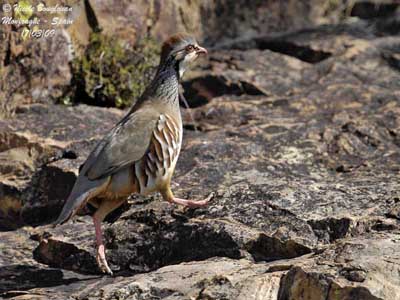
DIET:
Red-legged Partridge feeds mainly on plant matter such as seeds, leaves, roots, grasses and legumes. It may take fruits occasionally. It also consumes ants, grasshoppers and other insects’ species, especially in summer.
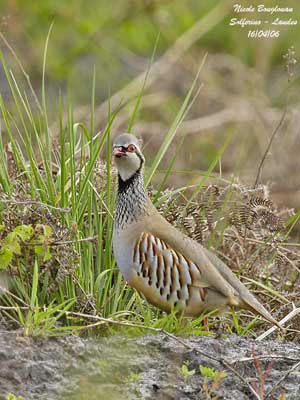
PROTECTION/THREATS/STATUS:
Red-legged Partridge is fairly common or common in suitable habitat where not overhunted.
This species is highly appreciated as game bird, and heavily hunted, but restocking with captive-bred birds allows having safe population numbers, in spite of declines in the native range.
